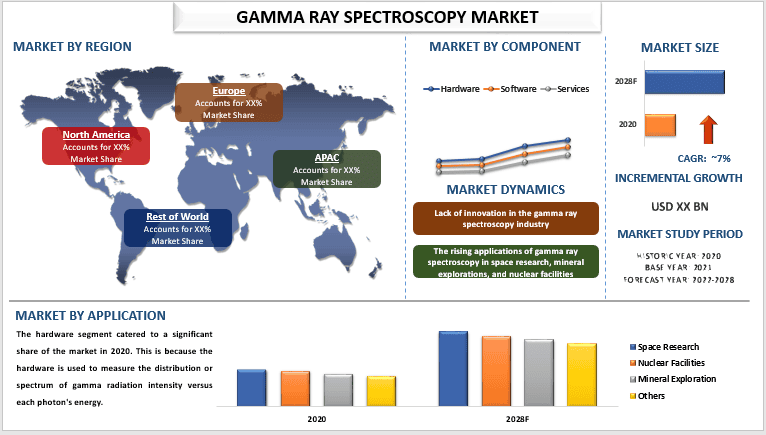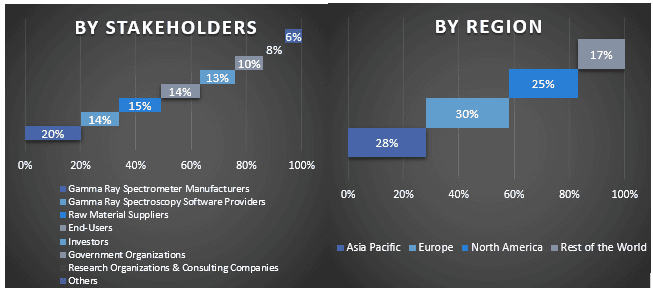- Home
- About Us
- Industry
- Services
- Reading
- Contact Us
Gamma Ray Spectroscopy Market: Current Analysis and Forecast (2022-2028)
Emphasis on Component (Hardware, Software, and Services); Application (Space Research, Nuclear Facilities, Mineral Exploration, and Others); and Region/Country

The Gamma Ray Spectroscopy Market is expected to grow at a strong CAGR of around 7% owing to the rising applications of gamma ray spectroscopy in space research, mineral explorations, and nuclear facilities. Gamma spectroscopy is a rapid, non-destructive analytical technique that can be used to identify various radioisotopes in a sample. A gamma ray spectrometer (GRS) is a device that measures the distribution of the intensity of gamma rays and the energy of each photon. The main components of a gamma spectrometer are an energy-sensitive radiation detector and electronics that analyze the detector’s output signal such as a pulse sorter. Additional components may include signal amplifiers, speedometers, peak position stabilizers, and data processing equipment.
Some of the major players operating in the market include CAEN S.p.A., Mirion Technologies Inc., AMETEK Inc., Sanders Geophysics Ltd., Linde PLC, NuviaTech Instruments, XIA, Kromek, Antech, and ATOMTEX Several M&As along with partnerships have been undertaken by these players to facilitate customers with hi-tech and innovative products/technologies.
Insights Presented in the Report
“Amongst component, the hardware segment held a prominent share of the market in 2020”
Based on component, the market is segmented into hardware, software, and services. The hardware segment catered to a significant share of the market in 2020. This is because the hardware is used to measure the distribution or spectrum of gamma radiation intensity versus each photon’s energy. In the mineral exploration industry, gamma ray spectroscopy hardware offers a rapid and reliable radiometric method of analysis of uranium and/or thorium ores.
“Amongst application, mineral exploration segment to hold a significant share of the market during the forecast period”
By application, the market is classified into space research, nuclear facilities, mineral exploration, and others. The mineral exploration segment held a prominent share of the market in 2020 and is expected to grow at a strong CAGR during the forecast period owing to the ongoing mineral exploration projects around the world for searching the radioactive fundamentals elementals mostly uranium and thorium, these are two elements found naturally in the Earth’s crust.
“Asia-Pacific to lead the growth in the forecast period”
The Asia-Pacific captured the highest share of the market in 2020. The Asia-Pacific region is anticipated to grow at a substantial CAGR during the forecast period. The region’s large share can be attributed to the upcoming space research missions, the construction of nuclear facilities in countries such as China and India, and the presence of a large quantity of uranium mainly in Kazakhstan, Uzbekistan, China, and others. For instance, according to World Nuclear Association (WNA), In 2021, Kazakhstan produced the largest share of mined uranium (45% of global supply), followed by Namibia (12%) and Canada (10%).
Reasons to buy this report:
- The study includes market sizing and forecasting analysis validated by authenticated key industry experts.
- The report presents a quick review of overall industry performance at one glance.
- The report covers an in-depth analysis of prominent industry peers with a primary focus on key business financials, product portfolios, expansion strategies, and recent developments.
- Detailed examination of drivers, restraints, key trends, and opportunities prevailing in the industry.
- The study comprehensively covers the market across different segments.
- Deep dive regional level analysis of the industry.
Customization Options:
The global gamma ray spectroscopy market can further be customized as per the requirement or any other market segment. Besides this, UMI understands that you may have your own business needs, hence feel free to connect with us to get a report that completely suits your requirements.
Table of Content
Research Methodology for the Gamma Ray Spectroscopy Market Analysis (2022-2028)
Analyzing the historical market, estimating the current market, and forecasting the future market of the global gamma ray spectroscopy market were the three major steps undertaken to create and analyze the adoption of gamma ray spectroscopy in major regions globally. Exhaustive secondary research was conducted to collect the historical market numbers and estimate the current market size. Secondly, to validate these insights, numerous findings and assumptions were taken into consideration. Moreover, exhaustive primary interviews were also conducted, with industry experts across the value chain of the global gamma ray spectroscopy market. Post assumption and validation of market numbers through primary interviews, we employed a top-down/bottom-up approach to forecasting the complete market size. Thereafter, market breakdown and data triangulation methods were adopted to estimate and analyze the market size of segments and sub-segments of the industry pertains to. Detailed methodology is explained below:
Analysis of Historical Market Size
Step 1: In-Depth Study of Secondary Sources:
Detail secondary study was conducted to obtain the historical market size of the gamma ray spectroscopy market through company internal sources such as annual reports & financial statements, performance presentations, press releases, etc., and external sources including journals, news & articles, government publications, competitor publications, sector reports, third-party database, and other credible publications.
Step 2: Market Segmentation:
After obtaining the historical market size of the gamma ray spectroscopy market, we conducted a detailed secondary analysis to gather historical market insights and share for different segments & sub-segments for major regions. Major segments are included in the report as component and application. Further country-level analyses were conducted to evaluate the overall adoption of testing models in that region.
Step 3: Factor Analysis:
After acquiring the historical market size of different segments and sub-segments, we conducted a detailed factor analysis to estimate the current market size of the gamma ray spectroscopy market. Further, we conducted factor analysis using dependent and independent variables such as component and application of the gamma ray spectroscopy market. A thorough analysis was conducted for demand and supply-side scenarios considering top partnerships, mergers and acquisitions, business expansion, and product launches in the gamma ray spectroscopy market sector across the globe.
Current Market Size Estimate & Forecast
Current Market Sizing: Based on actionable insights from the above 3 steps, we arrived at the current market size, key players in the global gamma ray spectroscopy market, and market shares of the segments. All the required percentage shares split, and market breakdowns were determined using the above-mentioned secondary approach and were verified through primary interviews.
Estimation & Forecasting: For market estimation and forecast, weights were assigned to different factors including drivers & trends, restraints, and opportunities available for the stakeholders. After analyzing these factors, relevant forecasting techniques i.e., the top-down/bottom-up approach were applied to arrive at the market forecast for 2028 for different segments and sub-segments across the major markets globally. The research methodology adopted to estimate the market size encompasses:
- The industry’s market size, in terms of revenue (USD) and the adoption rate of the gamma ray spectroscopy market across the major markets domestically
- All percentage shares, splits, and breakdowns of market segments and sub-segments
- Key players in the global gamma ray spectroscopy market in terms of products offered. Also, the growth strategies adopted by these players to compete in the fast-growing market
Market Size and Share Validation
Primary Research: In-depth interviews were conducted with the Key Opinion Leaders (KOLs) including Top Level Executives (CXO/VPs, Sales Head, Marketing Head, Operational Head, Regional Head, Country Head, etc.) across major regions. Primary research findings were then summarized, and statistical analysis was performed to prove the stated hypothesis. Inputs from primary research were consolidated with secondary findings, hence turning information into actionable insights.
Split of Primary Participants in Different Regions

Market Engineering
The data triangulation technique was employed to complete the overall market estimation and to arrive at precise statistical numbers for each segment and sub-segment of the global gamma ray spectroscopy market. data was split into several segments & sub-segments post studying various parameters and trends in the areas of the component and application in the global gamma ray spectroscopy market.
The main objective of the Global Gamma Ray Spectroscopy Market Study
The current & future market trends of the global gamma ray spectroscopy market were pinpointed in the study. Investors can gain strategic insights to base their discretion for investments on the qualitative and quantitative analysis performed in the study. Current and future market trends determined the overall attractiveness of the market at a regional level, providing a platform for the industrial participant to exploit the untapped market to benefit from a first-mover advantage. Other quantitative goals of the studies include:
- Analyze the current and forecast market size of the gamma ray spectroscopy market in terms of value (USD). Also, analyze the current and forecast market size of different segments and sub-segments
- Segments in the study include areas of the component and application
- Define and analysis of the regulatory framework for the gamma ray spectroscopy industry
- Analyze the value chain involved with the presence of various intermediaries, along with analyzing customer and competitor behaviors of the industry
- Analyze the current and forecast market size of the gamma ray spectroscopy market for the major region
- Major countries of regions studied in the report include Asia Pacific, Europe, North America, and the Rest of the World
- Company profiles of the gamma ray spectroscopy market and the growth strategies adopted by the market players to sustain in the fast-growing market
- Deep dive regional level analysis of the industry
Related Reports
Customers who bought this item also bought










